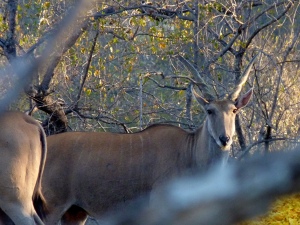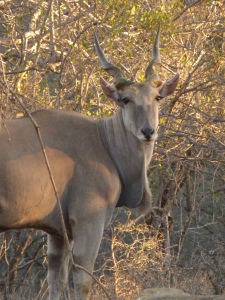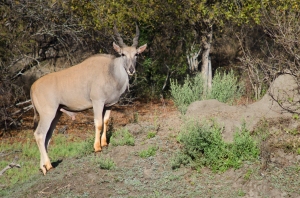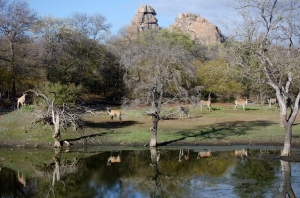SA Animal Profile – Eland and the mystery of the clicking
The eland, Tragelaphus oryx, is an intriguing animal, though of course to me, every animal is intriguing. The largest antelope in southern Africa, it seems that they’re often dismissed in favour of more elusive or prettier animals. With a large bovine-like torso and tan to grey colouration, it could be said that they aren’t the most beautiful of the antelopes out here. However, if you delve a little deeper, you’ll find that they are an impressive animal full of surprises.
The first thing that struck me when I came across eland on the reserve was their size. In truth, it shouldn’t have, I had already known they were the largest antelope in the region and having already met kudu, another large species, I should’ve been mentally prepared. Yet it was still a revelation. A large male (known as a bull) can reach 1.7m at his shoulder, with a female (a cow) only slightly shorter at 1.5m. Bearing in mind that doesn’t account for a lifted head or their horns, and that I’m only 1.5m high myself, I was a little taken aback – even though I sitting in the back of a pickup at the time.
Unlike most of the other local antelope such as impala, waterbuck and kudu, both sexes have horns which are relatively straight but twist round. According to an article in Wild magazine; the horns of a female are longer, more widely set and thinner than the male’s. Whilst the adults are rarely predated due to their size, their offspring is vulnerable and the horns provide a weapon for parental protection.
The background reading for this profile produced a fact that I had come across before. The eland has a very fast walking pace, too fast for a human to keep up. In addition, their trot at 22km/hr can be maintained for many hours, both useful for covering ground rapidly. This is attributed to their “lifestyle” of nomadity, rather than defending territories, where they move according to the feeding resources available.
Another movement executed by the eland, unexpected but reasonable, is their jumping. Imagine an individual if you will, the large cumbersome torso and a weight of between 460kg (cow) – 700/840kg (male average/maximum). Then imagine a wall next to it, 2m high – that’s 30cm higher than a male, half a metre higher than a female. And finally, imagine that eland jumping over said wall. From a standing position. An impressive feat. Compare that to another source of background reading which says they can actually jump 3m from a standing start.
The last exciting fact I’ll mention, though the eland has many more interesting features, is something of a mystery. Listen out next time you’re in the bush, and you might hear an odd clicking sound, like two bits of wood tapped together. One line of thought is that the clicking is caused by the hooves when the two halves clap against each other whilst moving. Another, which I think is the most believed, is that a tendon snaps when slipping over the animal’s knee joint. It may be that this clicking allows them to stay together easier, and one study suggests that it is used in hierarchy and dominance by the eland bulls. Either way, it’s quite useful for me when I’m in the thicker bush as it tells me when there are eland nearby.
Naturally, I’ve not covered every aspect of the eland’s morphology, ecology or behaviour, that could be excessive. Instead, I’ve chosen those which I found particularly interesting. Hopefully, what I’ve covered will persuade you to not underestimate this docile-looking species, and appreciating them for their unique characteristics. Perhaps you will join me in discovering that they have their own type of beauty.





Leave a Reply
Want to join the discussion?Feel free to contribute!